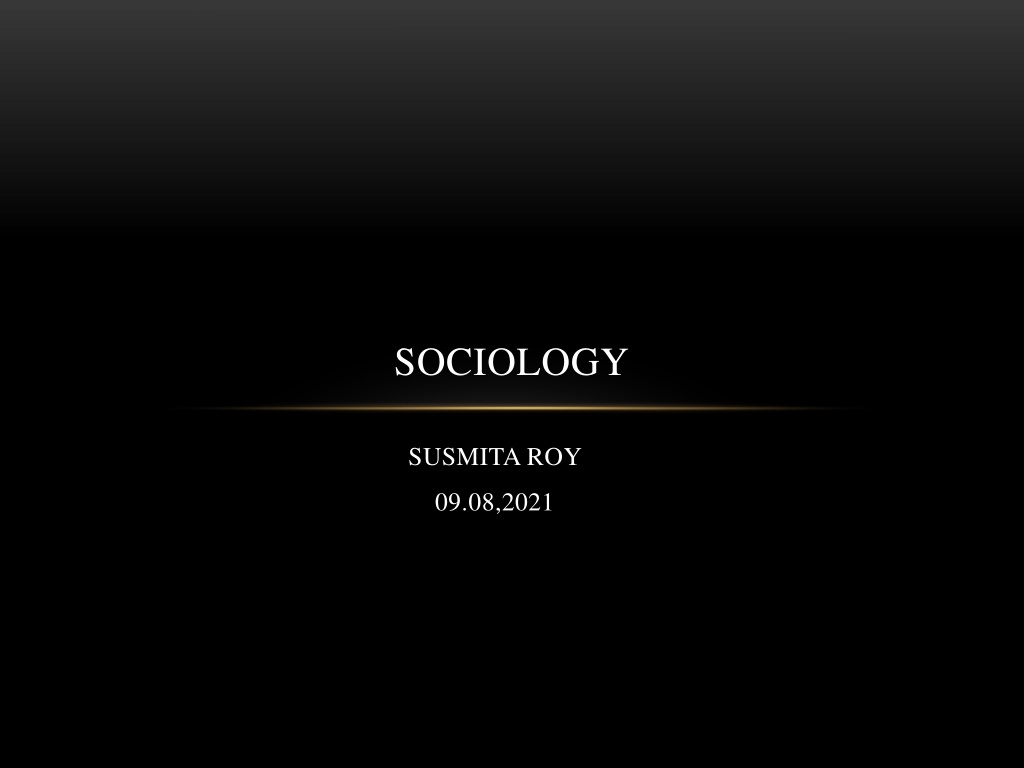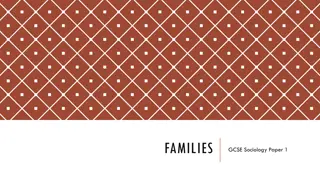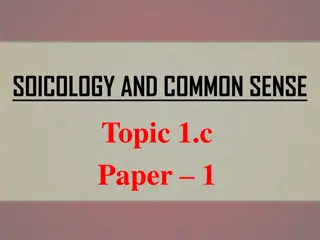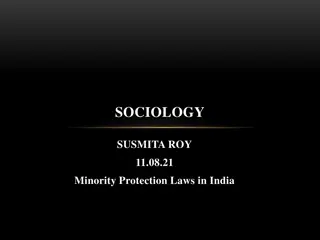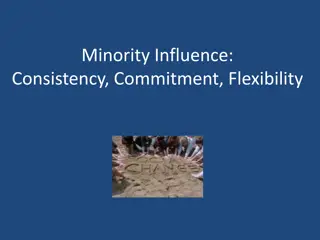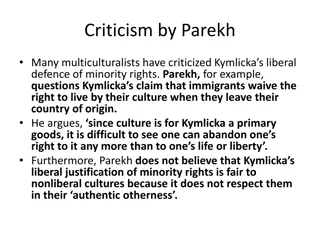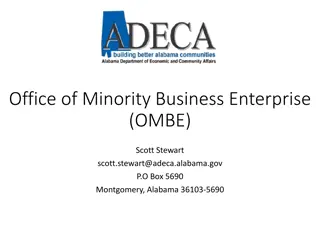Understanding Minority Groups in Sociology
Sociologist Louis Wirth defined minority groups as those singled out in society for differential treatment due to physical or cultural characteristics, leading to collective discrimination. Membership is both objectively ascribed and subjectively applied. Minority group status can be based on race, ethnicity, gender, and sexuality. This status is categorical, subjecting individuals to similar treatment. Ethnic minorities share a common heritage and can vary in political power. Gender and sexuality minorities, such as LGBT individuals, are recognized as minority groups. Religious minorities have different beliefs from the majority, and societal acceptance of religious freedom varies globally.
Download Presentation

Please find below an Image/Link to download the presentation.
The content on the website is provided AS IS for your information and personal use only. It may not be sold, licensed, or shared on other websites without obtaining consent from the author. Download presentation by click this link. If you encounter any issues during the download, it is possible that the publisher has removed the file from their server.
E N D
Presentation Transcript
SOCIOLOGY SUSMITA ROY 09.08,2021
MINORITY GROUPS Sociologist Louis Wirth defined a minority group as a group of people who, because of their physical or cultural characteristics, are singled out from the others in the society in which they live for differential and unequal treatment, and who therefore regard themselves as objects of collective discrimination. In the social sciences, minority does not just refer to a statistical measure and can instead refer to categories of persons who hold few or no positions of social power in a given society. Sociologist Louis Wirth defined a minority group as a group of people who, because of their physical or cultural characteristics, are singled out from the others in the society in which they live for differential and unequal treatment, and who therefore regard themselves as objects of collective discrimination. This definition includes both objective and subjective criteria: membership of a minority group is objectively ascribed by society, based on an individual s physical or behavioral characteristics, such as ethnicity and race or gender and sexuality. It is also subjectively applied by its members, who may use their status as the basis of group identity or solidarity.
Minority group status is also categorical in nature: an individual who exhibits the physical or behavioral characteristics of a given minority group will be accorded the status of that group and be subject to the same treatment as other members of that minority group. Racial or Ethnic Minorities Every large society contains ethnic minorities: subgroups that share a common heritage, which often consists of a shared language, culture (often including a religion), or ideology that stresses common ancestry or endogamy. In this case, while minority status can be conditioned by a clear numerical difference, more significantly it refers to issues of political power. In some places, subordinate ethnic groups may constitute a numerical majority, such as blacks in South Africa under apartheid. In addition to long-established ethnic minority populations in various nation-states, ethnic minorities may consist of more recent migrant, indigenous, or landless nomadic communities residing within, or between, a particular national territory.
Gender and Sexuality Minorities Recognition of lesbian, gay, bisexual, and transgender people as a minority group or groups has gained prominence in the Western world since the nineteenth century. The abbreviation LGBT is currently used to group these identities together. The term queer is sometimes understood as an umbrella term for all non-normative sexualities and gender expressions but does not always signify a minority; rather, as with many gay rights activists of the 1960s and 1970s, it sometimes represents an attempt to highlight sexual diversity in everyone. While in most societies the numbers of men and women are roughly equal, the status of women as a oppressed group has led some, such as feminists and other participants in women s rights movements, to identify them as a minority group. Religious Minorities Persons belonging to religious minorities have a faith which is different from that held by the majority population or the population group that is in power. It is now accepted in many multicultural societies around the world that people should have the freedom to choose their own religion, including not having any religion (atheism or agnosticism), and including the right to convert from one religion to another. However, in some countries this freedom is still either formally restricted or subject to cultural bias from the majority population.
People with Disabilities The disability rights movement has contributed to an understanding of people with disabilities as a minority or a coalition of minorities who are disadvantaged by society, not just as people who are disadvantaged by their impairments. Advocates of disability rights emphasize differences in physical or psychological functioning, rather than inferiority: for example, some people with autism argue for acceptance of neuro-diversity, in the same way in which opponents of racism argue for acceptance of ethnic diversity. The deaf community is often regarded as a linguistic and cultural minority rather than a group with disabilities, and some deaf people do not see themselves as having a disability at all. Rather, they are disadvantaged by technologies and social institutions that are designed to cater to the dominant, hearing-unimpaired group.
Characteristics of Minority Groups Charles Wagley and Marvin Harris (1958) opined that minorities could be identified by five distinct characteristics: Unequal Treatment and Limited Power Minority groups are often marginalised in their respective territories and have little to no say in governance owing to their virtual absence or limited presence in representative governance. The Dalit minority in India, for example, is socially ostracised, economically disadvantaged and politically under-represented. Distinguishing Physical or Cultural Traits Certain minority groups, primarily racial and ethnic minorities, are often identified using their physical features or cultural heritage. For example, the African-American population in the United States is determined using the colour of their skin. Similarly, the Bodo people of Assam are considered an ethnolinguistic minority that have a distinct shared language. Involuntary Membership in the Group As opposed to voluntary group membership, wherein a person consciously chooses to associate themselves with a particular group, involuntary membership is generally determined by birth or kinship. Members of minority groups are typically born into their social identity and therefore find it increasingly difficult to disassociate from it. The caste system in India, for example, segregates Hindus into various castes and sub-castes solely based on birth. Thus, an individual born into a Brahmin family will own the identity of a Brahmin, whereas one born into a Dalit family will be identified as a Dalit. Similarly, an individual does not choose their race, gender, sexuality, etc.
Awareness of Subordination Members of minority groups are generally aware of their subordination in society. This goes beyond just the knowledge of being a subordinate group. Minorities are conscious about the fact that as a result of their social identity, they are subjected to unequal social, economic and political opportunity. They recognise that they have narrower access to education, health care and other necessary infrastructure. High-rate of In-group Marriage Minority groups tend to practice endogamy, i.e., to marry within their group/community. Endogamy is a common practice amongst tribal population across the world and also caste minorities in India. Part of the reason for this in- group marriage is the desire to preserve the gene pools and ancestry in certain tribes. Another explanation, at least within the Indian context, is the social prohibition of inter-caste marriages in an attempt to restrict the social mobility of the lower castes and contain the social power amongst the upper castes. Types of Minority Groups Based on this definition of minority groups, we can categorise minority groups into four broad types: Racial and Ethnic Minorities: The terms race and ethnicity , often used interchangeably, refer to two distinct types of social identity. While the term race defines individuals using their physical characteristics such as skin colour and facial structure, ethnicity points to a shared heritage, language and even culture. Ethnic and racial minorities exist in nation-states across the globe; however, they are not always determined by apparent numerical differences. As stated earlier, the term minority is often used to refer to groups lacking social or political power. For example, the blacks in South Africa, during the apartheid, owned the numerical majority in the nation-state; however, they were still subjected to institutionalised racism by the white minority.
Ethnic and racial minority populations in any region are usually nomadic populations, recent migrants or indigenous populations. The most typical examples of ethnic/racial minorities would be the aboriginal and tribal populations of previously colonised nations. Aboriginal Australians, Native Americans in the United States and the Maoris in New Zealand are a few such indigenous groups that have been given the status of minorities. Gender and Sexuality Minorities These typically refer to groups that identify themselves as members of the LGBTQ+ community and includes people who identify as transgender, gender non-binary, homosexual, bisexual, etc. In certain societies, women are also considered a minority group despite their numerical strength because of their status as an oppressed group. People with non-normative gender and sexual identities have historically been denied equal rights and protection under the law. While Western society has been working towards inclusivity for the past century, Eastern cultures have only now begun to engage in conversations that recognise non-normative identities. Religious Minorities Minority groups defined by religion are those whose religious identity is subscribed to by a numerically weaker section of society and is different from that of the majority of the population that often holds power. While several nations worldwide allow their citizens the freedom to practice the religion of their choice without discrimination, there are others such as Myanmar and China that restrict such freedom through cultural bias. For example, the Uyghur Muslims in China and the Rohingyas in Myanmar are recognised as minority groups. As a result, they have been subjected to deplorable institutionalised discrimination, injustice, ill-treatment and horror in their respective states.
People with Disabilities Despite being a hotly debated matter, people with disabilities physical or psychological have been found to form the largest minority group globally, with over one billion people living with some form of disability. Neuropsychiatric disorders, sensory impairment, loss of physical mobility, etc., are regarded as causes of disability. People with disabilities are not only disadvantaged by their impairments but also by society. People with disabilities are at a higher risk of being subjected to violence, disaster and poverty and therefore must be given due consideration under the law. Problems Faced by Minorities The difficulties faced by members of minority groups are trifold social, economic and political. Firstly, members of minority groups have to grapple with the idea of social identity. It becomes challenging for them to pave a path for themselves in a society ruled by a majority with evidently different social, cultural, and behavioural practices. Their source of identity, which is their means to navigate the world, also becomes a cause for discrimination and injustice. Additionally, the minority community is continually deprived of equal opportunity to education, employment, health care and social welfare. Such unequal treatment acts as an impediment to social mobility and dignified existence.
Furthermore, social and economic insecurity becomes commonplace in the lives of minorities. Their weak numerical presence and their inability to access equal opportunities for growth and well-being become a source of anxiety and vulnerability. Such marginalisation also leads to the deterioration of the physical and mental health of minorities. The scapegoat theory in psychology refers to the tendency to hold someone else accountable for one s own problems. When applied to sociology, we can see that such scapegoating gives rise to prejudice and discrimination towards the group or person being held accountable. Scapegoating is a widespread occurrence among minority groups. Majority groups often displace unwarranted aggression onto subordinate groups. Adolf Hitler, most famously, is guilty of such action during the 20th century. He blamed the Jewish population for Germany s social and economic struggles and consequently fuelled an ethnic genocide against the Jews. Scapegoating is also the primary reason for hostility towards immigrants. In a world where our social identity is intricately connected to our understanding of the Self and how we view and perceive our social and physical environments, it becomes imperative to engage in discourse about the rights and freedoms of minorities. The denial of opportunity and oppression of individuals that stems from prejudice and stereotyping has dangerous consequences for communities. Educating ourselves about the plight of minorities and the factors that influence such discrimination is the first step to changing the narrative around subordinate groups.
REFERENCES BERBRIER, M. (2002, JUNE). DISEMPOWERING MINORITIES: A CRITIQUE OF WILKINSON S TASK FOR SOCIAL SCIENTISTS AND PRACTITIONERS. JEFFERSON, T. (1801, MARCH 4). JEFFERSON QUOTES & FAMILY LETTERS. EXTRACT FROM THOMAS JEFFERSON S C.N.RAO
